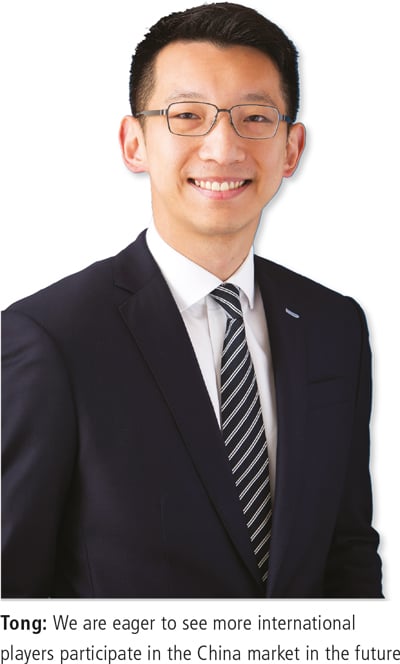The biggest success story of China and Hong Kong’s asset management industry in 2016 is how J.P. Morgan Asset Management (JPMAM) quietly captured nearly all of the China-Hong Kong Mutual Recognition of Funds (MRF) market.
This achievement is a result of a number of factors including having the right product, distribution channels and brand building.
Just nine months after launching its first MRF fund, JPMAM has established a 90% share of the MRF’s 9.7 billion (US$1.4 billion) in total assets (as of September 2016).
It was only in January last year when the first MRF-approved Hong Kong funds were launched into the China market.
The MRF is a scheme which allows Chinese and Hong Kong fund managers to sell their funds in each other’s markets.
In less than 12 months JPMAM has managed to attract more inflows than any other offshore fund manager in China with the bulk of inflows coming in during the third quarter of 2016 alone.
In June, JPMAM sales of MRF funds amounted to 2.8 billion yuan, increasing dramatically to 4.8 billion yuan in July, to 7.6 billion yuan in August and to 8.6 billion yuan in September.
Considering that the MRF is a newly opened market, JPMAM’s experiences in building its business to such a massive size so quickly presents some lessons to competitors who may be eyeing the MRF market too.
When the MRF was launched on May 22 2015, Hong Kong’s big global fund managers, including JPMAM, had to scramble to meet regulatory requirements for fund launches.
Because the regulators kept details of the scheme confidential until the last minute, the Hong Kong-based fund managers were left clueless on how to prepare for the MRF. Thus, after its launch, when details of the scheme were finally known, it became a race to get the first MRF fund into the mainland market. But to do this the fund managers had to do a lot of work.
JPMAM strategy
As with any new scheme, first, they had to build their brand in China. Since most of the Hong Kong fund managers are relatively unknown in the mainland, this is not a simple task.
As with any new scheme, first, they had to build their brand in China. Since most of the Hong Kong fund managers are relatively unknown in the mainland, this is not a simple task.
In the case of JPMAM, it had an edge when it comes to brand building. First, it has been investing in China long before the MRF being an established player in the Qualified Domestic Institutional Investor and Qualified Foreign Institutional Investor programmes.
Second, JPMAM has mainland joint venture known as the China International Fund Management Co (CIFM), which was founded in 2004. This means that mainland investors were already familiar with JPMAM through CIFM.
Next, under the MRF Hong Kong fund managers cannot enter into distribution agreements with mainland distributors directly. Instead, they need to appoint a master agent in China who will be authorized to enter the distribution agreements with the mainland distributors.
This requirement involves a multi-step process whereby the Hong Kong fund managers has to identify a master agent, enter into an agreement and sort out a distribution structure with their master agent, then the master agent enters into distribution agreements with the local distributors, typically the big domestic banks.
In the case of JPMAM, it naturally authorized CIFM as its master agent. CIFM already had established relationships with many distributor banks in China. JPMAM was able to leverage these relationships in building its distribution network for the MRF. In fact, the big fund inflows that JPMAM experienced from July to September was attributed to a number of distributors coming online.
Since then JPMAM, through CIFM, has grown its distribution network from eight channels in January 2016 to 16 channels currently. This includes big domestic banks such Bank of China, China Merchants Bank as well as an online distributor like Ant Financial.
Perhaps the most important lesson from JPMAM’s MRF experience is having the right product ready at the right time.
Under MRF, the regulators have imposed a strict set of requirements for funds that can be offered for sale in China. Regulators require the funds have to be registered in Hong Kong, domiciled in the city, and managed in Hong Kong. The funds must have a minimum track record of two years, and have minimum assets of 200 million yuan.
In addition, the fund is only allowed to sell the same amount of assets in China that it has in Hong Kong. For example, a Hong Kong-MRF fund with 200 million yuan in assets can only sell a maximum of 200 million yuan in assets in China.
JPMAM was one of few fund managers who had funds that met these stringent criteria when the MRF was launched. Initially, the China Securities Regulatory Commission (CSRC) approved only three MRF funds for sale in China. One of these was the JP Morgan Asian Total Return Bond Fund, which was approved on December 18 2015. This fund catered to the strong demand for less volatile fixed income products among Chinese investors.
The second batch of three MRF funds was approved by the CSRC in February 2016. This batch included the JP Pacific Securities Fund, an Asia-including Japan, all equities fund designed to provide diversification for mainland investors away from A-shares.
However it is the bond fund that has been most attractive to mainland investors resulting in the huge inflows for JPMAM during the July-September period. Demand for this fund has been overwhelming that JPMAM had to restrict subscriptions because of overcapacity concerns. Since late August, JPMAM has put restrictions on large-volume (10,000 yuan or US$1,000) subscriptions to JP Morgan Asian Total Return Bond Fund.
Building the business
Although the firm has achieved success during the first year of the MRF, a number of challenges still remain in building the business, says Henry Tong, head of China retail business of J.P. Morgan Asset Management in an interview with The Asset.
Although the firm has achieved success during the first year of the MRF, a number of challenges still remain in building the business, says Henry Tong, head of China retail business of J.P. Morgan Asset Management in an interview with The Asset.

First, JPMAM plans to build and deepen its relationships with mainland distributors in order to enhance client servicing and maximize sales.
“We’d like to build the level of relationships similar to those we have with our clients (distributors) in Hong Kong and the rest of the region. We’re not really planning to have a lot of distributors. We want to build a core group of distributors, I don’t know the exact number yet, with whom we can be long-term trusted partners,” Tong says.
JPMAM also plans to work more closely with the regulators in terms of building up its product range. The long-term objective is to be able to offer a full suite of funds that can meet the range of risk management requirements of mainland investors.
With this aim, JPMAM has already submitted a third MRF fund for approval to the CSRC. This is an A-share equity dividend fund that will invest purely in high dividend paying stocks.
“Now we have a growth product and fixed income, so we’ll try to offer something in the middle. This will be a mild-volatility product but investing purely in dividend paying equities. At present this type of fund is not popular in China because most of the A-shares are not dividend paying,” Tong says.
The bigger challenge is, however, getting mainland investors to understand the product offered by JPMAM and how these products can meet their investment requirements.
Tong also says he wants other Hong Kong fund managers to succeed in the MRF market since demand from investors and opportunities for fund managers are massive.
“It’s only the first year. More players will mean a much bigger and stronger market as well as more diversity in product offerings. In the future, we are eager to see more international players participating in the China market,” Tong says.





.jpg)
.jpg)


